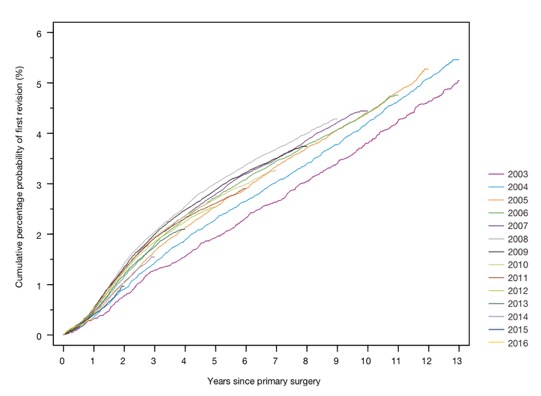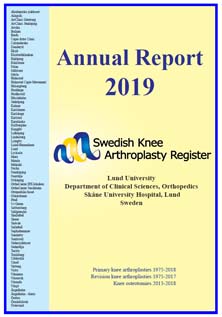How long does a knee replacement last?
“But knee replacements only last 10 years, don’t they?“…. No! – it’s not clear where this misnomer actually originated from, but it’s just not true: most knee replacements last a lot longer than 10 years!…
What's the average life expectancy of a knee replacement?
We’re absolutely not trying to be evasive here, but this is actually an impossible question to answer – and we’ll attempt to explain why…
To get a figure for ‘the average life-expectancy’ of a knee replacement prosthesis, one would have to, say, take 100 patients and then follow them up until each of them reached their ‘final outcome’…
If a knee replacement prosthesis fails within a patient’s lifetime and needs revision (a re-do), then that’s a simple clear outcome: a failure. However, what if a patient dies of something else, unrelated, with their knee replacement prosthesis still happily in place? You can’t really call that a failure of the prosthesis; however, you can’t say that it’s never failed, i.e. that it lasted ‘forever’… because the average of any group of numbers where even one of the numbers is ‘infinity’ is… infinity! Likewise, if someone is lost to follow-up and you never find out what happened to them, then do you classify that case as a failure or as lasting forever, or do you simply ignore it? If people lived forever and if we had 100% follow-up of all patients in all studies, then yes – we could wait however long might be necessary for each and every knee prosthesis to eventually wear out and fail, and then we could add up all the numbers of years, divide by the number of patients and come up with a figure for the average time that a knee replacement lasts. But we can’t do that.
What we can do, however, is say how many knees are still working successfully after say, 1 year, 5 years and then 10 years etc… and this is called ‘survivorship analysis’…
What's the chance of a knee replacement failing?
The first national registry collecting comprehensive long-term data on knee replacement outcomes was developed in Sweden back in 1975, over 40 years ago!
In the UK, the National Joint Registry was established in 2002 to collect information on all hip, knee, ankle, shoulder and elbow replacements. It has been gathering data since April 2003, and since 2011 data submission by all UK surgeons has been ruled as mandatory, and to-date over 1 million knee replacements have been registered, giving an invaluable resource of data.
Roughly speaking, one should expect at least 95% of knee replacement prostheses to still be working and in place (i.e. not yet revised) after 10 years of use, and over 80% to still be in place by the 20-year post-op mark.

What about the effect of age?
The younger you are, the more active you tend to be, and also the longer you would expect to (or at least hope to!) live…
The more active you are and the more you use any kind of artificial joint, then the faster the rate of wear and tear on the joint will be, and the quicker it will wear out and the sooner it will fail. (Artificial joints do not repair themselves or regenerate.)
Also, the younger you are then the more years of use your knee replacement prosthesis will be subjected to, and the more likely it will be that it might fail within your lifetime (as opposed to the knee outlasting you).
Therefore, the younger you are when you undergo knee replacement surgery, the greater the probability will be of you potentially ending up needing a revision knee replacement within your lifetime… and revision knee replacements (re-do surgery) are twice as technically demanding, have double the potential risk of complications and are associated with significantly poorer outcomes compared to primary (first time) surgery.

Generally speaking, just as a rough guide:
- if you have a knee replacement in your 70’s, then there’s only a risk of about 10% of you potentially ending up needing revision surgery within your lifetime, and there’s a 90% chance that your new knee will outlast you; however,
- if you have your knee replacement when you’re only in your 50’s, then there’s a 50% risk of you eventually ending up needing revision knee replacement surgery at some later stage, within your lifetime.
This is one of the very important factors that you should take into consideration when deciding when the right time might be to actually go ahead with knee replacement surgery.
How long does a partial knee replacement last?
If only part (one ‘compartment’) of a knee joint is damaged and arthritic, and if the rest of the knee is in good enough condition, then you might potentially be a suitable candidate for (i.e. ‘get away with having’) a partial knee replacement instead of a total. It should, however, be noted that partial knee replacements are actually associated with slightly higher failure / revision rates compared to total knee replacements. There are, however, some very clear and specific reasons for this:
- Partial knee replacements tend to be performed in younger patients, compared to total knee replacements. As noted above, younger age is associated with greater risk of potential future revision.
- Partial knee replacements tend to give somewhat better outcomes than totals, with them feeling and moving more like the patient’s own normal knee. Therefore, people with partial knee replacements tend to be more active and return to higher-demand activities compared to total knee replacement patients… and again, as per above – the more active you are on an artificial joint, the faster the rate of wear and tear and the sooner it might eventually end up wearing out and failing.
- Next, if someone only has arthritis is one (or sometimes two) compartment(s) of their knee, and if they have a partial knee replacement (either unicompartmental or bicompartmental), then they may eventually end up developing arthritis in the rest of the knee too, i.e. in the other compartment(s). If this does happen, then they might need their partial knee replacement converting to a total knee replacement.
- Finally, it is considerably easier to revise a partial knee replacement to either another partial replacement or, far more often, to a total knee replacement… than it is to revision a total knee replacement. Surgeons therefore tend to have a lower threshold for potentially recommending revision surgery in someone who has a symptomatic partial knee replacement in place compared to someone with a total knee prosthesis.

Importantly, however, this does not mean that total knee replacements are ‘better’ than partials! – Partial knee replacement is still an excellent potential option for a patient with unicompartmental (or sometimes, bicompartmental) knee arthritis, but careful patient selection is vital and appropriate pre-operative patient education and ensuring that the patient is an active part of the decision-making process is key!
Is 'revision rate' really the best measure of success?
Revision rate is just one of a number of different factors that can be used to assess potential ‘success’ after knee replacement surgery. Importantly, however, it would be completely wrong to say that a knee replacement prosthesis is a great success, just because it’s lasted many years, if the patient themself has actually been left with a painful or stiff knee, with poor function, and if they’ve had to endure years of unhappiness and disappointment! Just because a knee prosthesis hasn’t been revised, it doesn’t mean that the patient themselves, are actually happy and that they personally would consider the surgery as a success.
Patient satisfaction, function, knee kinematics and prosthetic survivorship are all factors that influence and contribute to overall ‘success’ after knee replacement surgery, and one has to consider each of them individually, but also all of them collectively, when considering actual outcomes after knee replacement surgery.
CLICK HERE to read more.
Further information...

CLICK HERE to find out more about the UK National Joint Registry

CLICK HERE to read the 2019 Annual Report from the Swedish Knee Registry.
